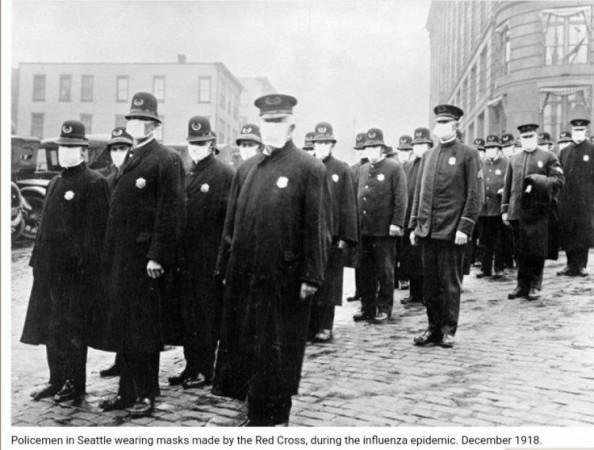As we enter the second year of the COVID-19 pandemic, the end of its rampage seems nowhere near. Nearly all countries across the world are reporting a second onslaught or 'wave' of the SARS-CoV-2 coronavirus-caused infection, with some countries including India witnessing a more aggressive spread. Around 100 years ago, another pandemic devastated the world and claimed over 50 million worldwide—the Spanish Flu. Its second 'wave' is said to have been worse than the first. Perhaps, it's time to look to the past to survive the present?
Caused by the H1N1 influenza A virus, the pandemic lasted approximately between February 1918 to April 1920. Nearly one-third of the global population at the time, or 500 million, were infected by the disease. Most countries faced three successive waves, with the second wave decimating several countries according to historians.
Not A 'Spanish' Flu

While the origin of the virus is debated, the first known case was reported in Kansas, USA, in March 1918. Cases emerged in European countries such as the United Kingdom, France, and Germany, over the next few months. Bound by strict censorship due to World War I, the native press in these countries was prohibited from publicizing the illness.
Spain, which was a neutral non-participant of the war, had no information blackouts like its neighbours and permitted free reportage. Ironically, since the Spanish press was the first to report about the deadly disease, the misnomer emerged—the Spanish flu.
The first wave of the pandemic occurred during the spring of 1918. Its severity was relatively mild. Most of the infected suffered from symptoms such as fever and fatigue that ran their course in about three days. The mortality rates were low and similar to that of seasonal flu. Unfortunately, WW I would become responsible for deaths not just on battlefields but also off them.
The Deadly Second Wave
As troops engaged in the war moved across different theatres, they carried the virus with them, and effectively led to the outburst of a more deadly wave. A new mutated strain spread across the globe in the fall of 1918. According to several studies, it was the single largest contributor to the second wave.

"The rapid movement of soldiers around the globe was a major spreader of the disease. The entire military-industrial complex of moving lots of men and material in crowded conditions was certainly a huge contributing factor in the ways the pandemic spread," James Harris, a historian at Ohio State University, told History Channel.
Coinciding with the final months of the war, the need to 'carry on' and keeping morale high received stronger emphasis. "It was the closing months of the war, a lot of people were dying, [so the government thought that] a few flu deaths here and there didn't make much difference," Mark Honigsbaum, a medical historian, told The Telegraph. By the end of the second wave, 30 million people across the world had succumbed to the disease. However, nearly 17 million of these deaths occurred in India.
A look back at the Flu Pandemic of 1918 through the holdings of the @USNatArchives
— US National Archives (@USNatArchives) May 6, 2020
Learn more: https://t.co/JObXmGYfES pic.twitter.com/otyM4YmsMx
Different Pandemics, Same Behaviour
It is not certain if we are entirely done with the second wave of COVID-19 globally. Therefore, it might be imperative to focus on the comparison of the similarities between the second waves of the two pandemics. Currently, governments across the world are appealing to their citizens to stringently adhere to the safety protocols to protect themselves from the novel coronavirus and restrict the spread of the disease. Surprisingly similar cries were made during Spanish flu as well.
"Everyone taking care of patients suffering from influenza and barbers, dentists, clerks, elevator operators, and others with similar professions, and those coming in close contact with crowds, shall wear masks," reads an excerpt from Influenza Regulations issued by the authorities of Ogden City, Utah, in 1918.
Wearing masks in public during 1918 epidemic indicated that health crisis was serious and required collective effort to contain spread of disease #Masks4All
— Tom Ewing (@EThomasEwing) May 19, 2020
Photo: US National Archives
Flu Masks Failed in 1918, but We Need Them Now @Health_Affairs https://t.co/IHNvrU1dHW pic.twitter.com/lq4UAwGlSg
Isn't the sight of people refusing to wear a mask or improperly sporting them below their chin a common and concerning one? Astonishingly, this was a problem even during the second wave of the Spanish flu. For example, over 1000 'mask slackers' were arrested in San Francisco, USA, following their failure to adhere to an ordinance that made mask-wearing mandatory.
According to several health experts, the surge in the number of cases during the second wave is due to the increasingly negligent attitude towards safety protocols; something that India is struggling with as well. Brain Dolan, a medical historian, points out in his paper that when conditions became worse during the flu, resistance to mandatory precautionary measures only increased. "The same people who celebrated their bare-faced 'liberation' when allowed to remove face masks in November 1918, now organized protests against the return of this public health measure," he writes, about the anti-mask resistance in the US in 1918.















